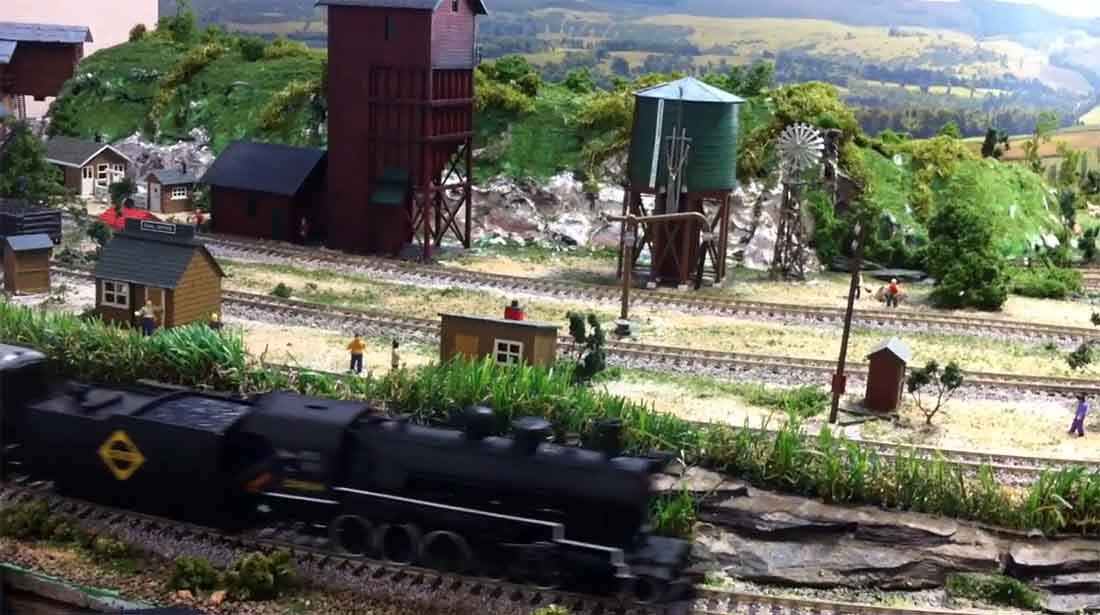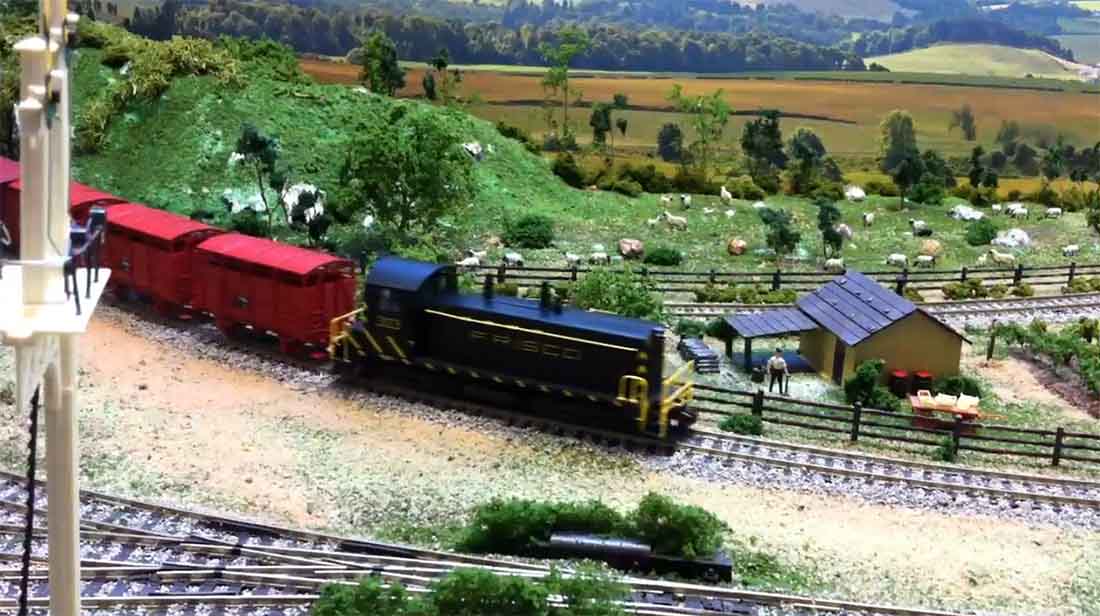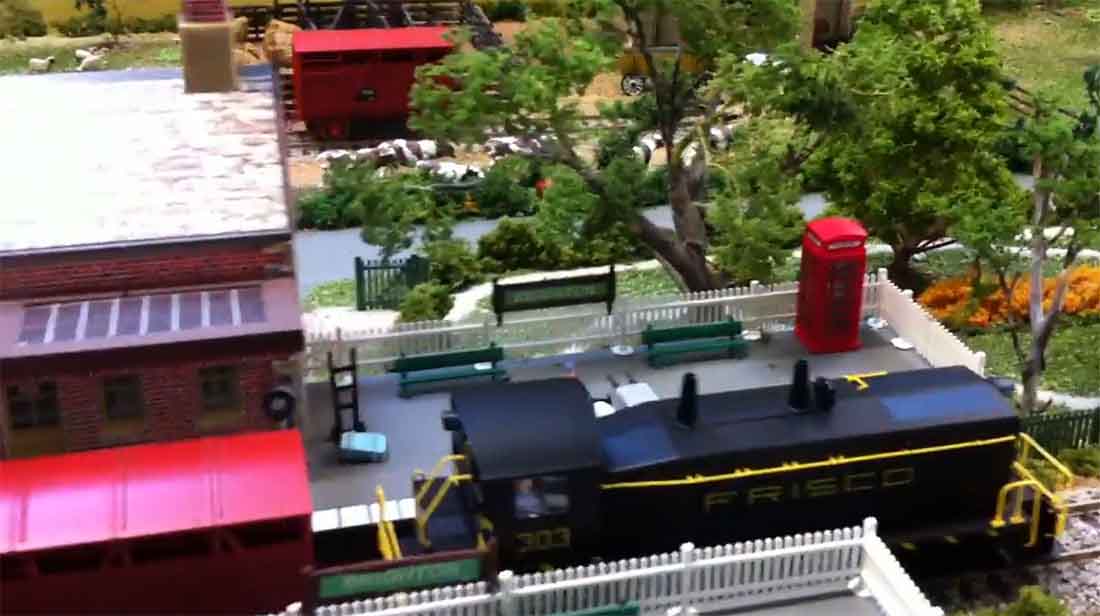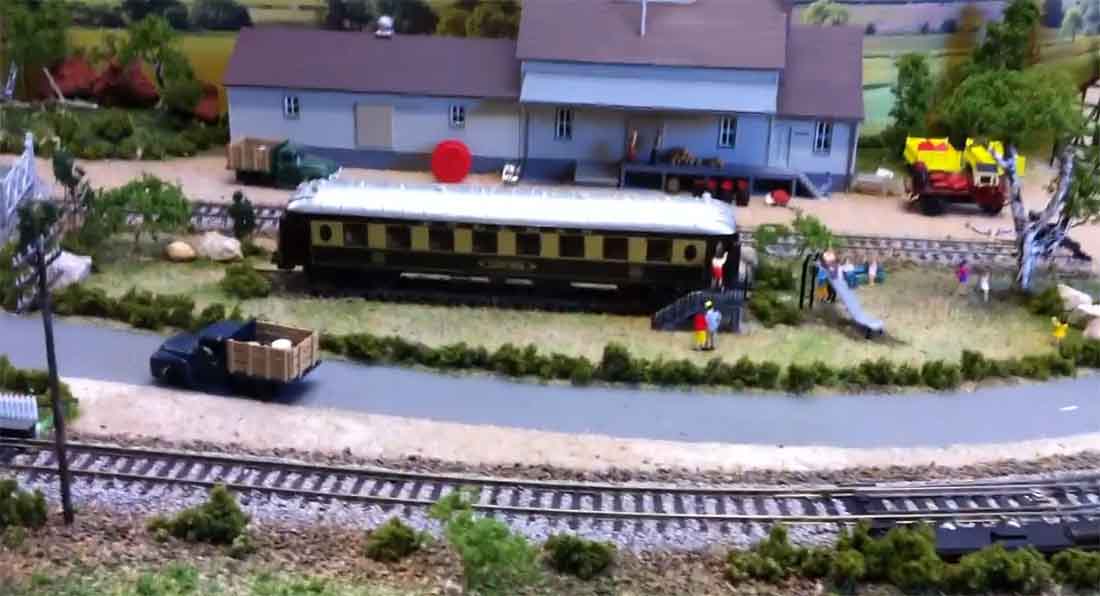“Hello Al,
Please accept my apologies in not answering you earlier.
As a retired electrical engineer, my hints and tips are electrically based.
When wiring your layout, buy a reel of alarm cable.
A 100 metre drum of 8 core alarm cable will cost under $20.00.
This will give you 800 metres of cable for $20.00 which is the equivalent of 25p per metre.
Sleeving is a thin walled pliable plastic tube which comes in red, brown, blue, black, grey and green/yellow.
3mm diameter should be adequate for most needs, and costs around $5.00 for 100 metres.
Push your cables through this sleeving. Use one sleeving colour for each function, e.g. red for track supplies, green/yellow for signalling, grey for points.
Use one colour per function which will make fault finding easier. E.g. when wiring points, I use green for the main line, red for the diversionary route and blue for the common return.
The alarm cable and sleeving may seem a large outlay, but when you compare the equivalent cost typically over $3 for 7 metres with buying 800 metres of connecting wire in small packets, the outlay is not so great.
Make a circuit diagram of your wiring.
Test each circuit and remedy any faults before going on to the next.
Regards
Cedric”
Some of you may remember John’s pics of his first layout (if you don’t, they are here).
Well, he’s been kind enough to take some video of it:
Big thanks to Cedric and John. Please keep ’em coming.
That’s all for today folks – please do keep ’em coming.
And if today is the big day when you get started on your layout, the Beginner’s Guide is here.
Best
Al
PS Latest ebay cheat sheet is here.







I am wiring my latest layout with 6 wire thermostat sleeved, six colored, 20 gauge cable wire. I use it to go from the control panel area to remote sections of the layout and fed to lights and switch track motors. On either end I have a break out terminal block, you can even integrate uses into one cable pull. I don’t recommend it for powering your track except for sidings etc.
Cedric –
Great tip. I too am a retired EE and would like to piggy back on your suggestion.
1. You may be able to find multi-conductor cable less expensive at
the local surplus electronics store.
2. At first, leave a couple of spare wires. Layouts tend to grow with time and it is easier to put in a few spares than to have to add to the congestion under a layout almost complete.
Barry
When developing a circuit, I like to temporarily use connecting-terminals with screws because it’s a lot easier during the project. When completely done, I remove the temporary terminals then solder most wires (especially low voltage circuits and/or thin wires), sometimes using crimp connectors for heavier wires … I was taught to do this as a “breadboard engineer” because, even though there’s two steps to the final wiring, it’s overall faster due to the time it takes to correct mistakes, especially when the final configuration is uncertain at the onset.
As good a video as I’ve seen recently… Please give us more….
one source of variable power is the old power pack out from your old desk top they are usually between 1.f volts to 12 volts 25 to 30 amps, this gives you enough power to control signals yard and street lights and of course all your buildings, the best thing is you don’t need resisters with your LEDs
great electrical tips and what a great video am interested in seeing more,
hello there…just watched your video and i am a new commer looking to make my first layout..
i really like what you have done and your ideas on different colored plastic tubing.
since i am new to the model railroading sence i do have a qhestion…what size or standard trains are these that you are showing in your video?
i am trying to figure out what size trains i should be thinking of…ho,n-gauge,18 gauge..really am confused…
any thought s on this would be very appreciated..
thank you
Roy in New york
Thank you for the super videotography (sp?). I was actually able to enjoy your wonderful handy work on your structures and scenery. If more people would take the time, not worry about the speed of the train, I would get more out of the videos. After all, you took the train out of the box, added a few details and put it on the rails. Where the train passes through however, takes months to get just right and then the photographer whizzes past following the train. Al however, has gotten many of his people who submit to slow down, let the train pas two times. Great job Al. I try never to miss an episode. Thank you. E.
Thanks for the few minutes of enjoyment and the tips on wiring.
Wow John. I thought my first attempt (at doing my father inlaws layout) was pretty good. You put me to shame!!! I’ve watched this video 3 times now picking up new ideas and new details each time. In short order we can see the thought you put into this. Bravo sir (tipping my hat to you)
A beautiful layout with lots of interesting terrain mixed with housing and town life. Wow!
very nice vid, proper speed, nice sound
What a deliciously detailed layout!!
Thanks…John
For Roy in New York, that layout would appear to be HO with various OO scenic and rolling stock items. The track gauge for both scales is the same (16.5mm) but HO is 3.5mm to the foot and OO is 4mm/foot, which is why those British Pullman cars look a bit large with that American loco. From the freight cars and the flag, I’m guessing John’s based in Australia?
John, was so engrossed watching your video I thought something had gone wrong with my computer when the video suddenly stopped. B****y fantastic effort mate, can’t wait to see more. Any chance of seeing a track plan and where did you get the backdrops?
I hope that when I start my first layout that I can get it to look half as good.
Cheer Mike from South Australia
Hi Roy
How about S gauge. It is just a little bit bigger than HO.
If you can get some Cat 5 cable it is already color coded. Same is true for telephone cable.
Very nice!!! Looking forward to your next video!
What a nice change to see trains moving at scale speed, and not travelling at 200 MPH.If you spend lots of time getting the scenery right and the scale right, it seems to me that the speed should be right as well
Nice layout John ….Dangerous Dave
Hi Everyone: Speaking of my “O” gauge layout I ran 14 gauge house wiring to terminal strips with 18 connections each to several locations on my layout. That gives you full power to remote locations for accessories. You can also use this for track power as well with only short connections to the track with bladed electrical connectors driven into the tubular spacing of Lionel and/or Gargraves track which I used.
Cedric
Great input here. Thanks
John
Video & layout topnotch-
Roy
There are not enough pages to begin this topic. I love and have tons of stuff in S scale- to me it is the best size for an old man like me. Built a layout then tore it down when I realized that I could not afford to continue in this scale and do what I wanted. I went to HO because you can buy what you want and pretty much develop very complex layouts, In my heart I just miss that S scale though.
Good luck
George from NY
“This will give you 800 metres of cable for £20.00 which is the equivalent of 25p per metre.”
I think this should be .025p per meter.. ? [2.5 pence/meter]
Peter [UK]
Excellent wiring tip.
I love the detail and sense of space in the layout. Brilliant!
One of the Best Model I have seen in a long time. Your attention to details is very evident and really makes the Model come alive. Well Done.
John, Loved the video of your layout. You run an interesting combination of US and European equipment. I really like all the little detailed scenes that make your layout come alive. It takes a certain artistic sense to create those little scenes that make the layout so much more interesting. I also really enjoyed the farm area with the crops and sheep in the pasture. Very well done! Hard to believe this is only your first layout. Would love to see your track plan and more videos if you can manage it.
Nice Layout. Interesting combination of track plan & scenery.
To Roy in NY: What Guage you chose to model in depends on two major points. How much space do you have and how much work do you want to do. N guage is the smallest, generally available, and takes up the least space for a nice looking and functioning layout. As you go larger in guage you need more space but can do more detail assuming you want to put more work and detail into your layout. Also there will be more accessories and additives the larger the scale. Having said that, N, HO and O generally offer more realism than larger guages which start to look like toy trains unless you are very talented with landscaping skills. Also something few beginners consider, how much wiring you want to do and will you have to move the layout in coming years. If moving is a possibility, then modular construction may be an option. Wiring will be dependent on how many switches, lights and active accessories you will have. Are you going to wire the tracjk or go DCC. A lot to think about before going down the wrong path and starting over. My best suggestion would be to visit model displays and clubs in your area; most have open houses throughout the year. Members are always willing to talk trains and you may get interested in joining a club which will be most helpful to a newcomer at all levels. Somewhere nearby you will find clubs in any guage you want to consider simply by doing web searches with your zip code. Each one you visit will have tons of useful info for a newbie as well as recommendations of other places to visit and buy from. North Jersey has several great layouts, assuming you’re in the city. Good luck. Ted in NJ
I really liked watching the video, especially when the GN Consolidated came into view. That grabbed my interest because my whole layout is GN. I have three separate venues: early GN (1930-40), mid-times (1950-60), and into Amtrack (1970- on).
i wish i was able to get mine set up again, but nice set up.
This sounds like to small a gauge for track power. This would be good for LED’s without resistors.